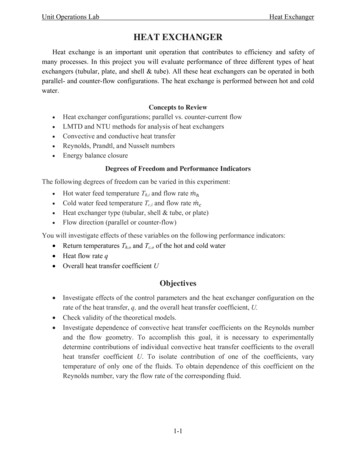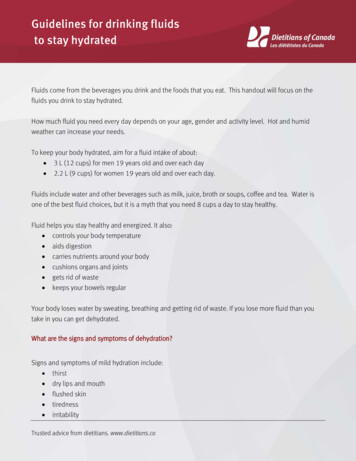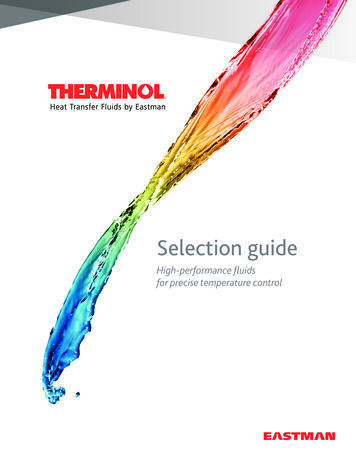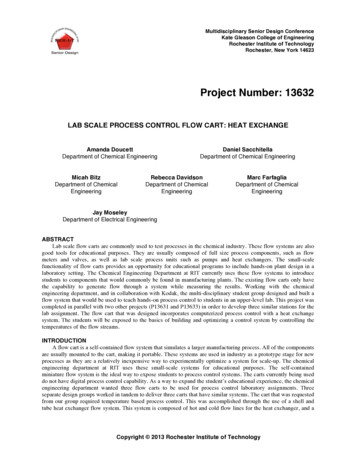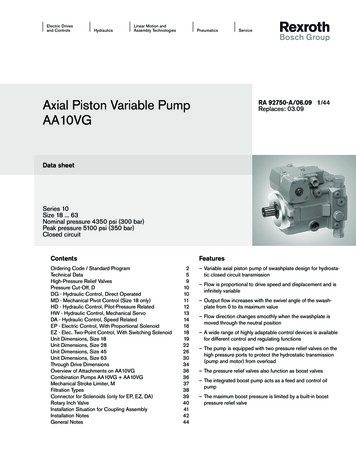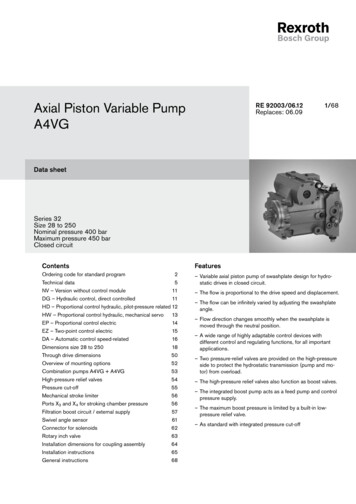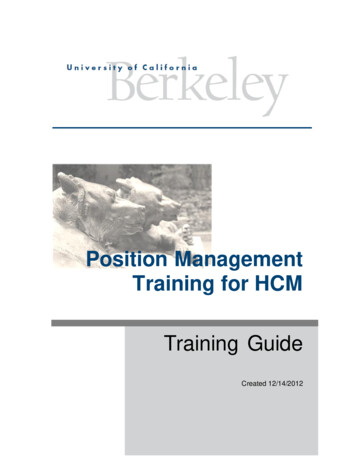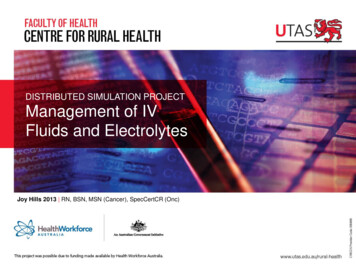
Transcription
DISTRIBUTED SIMULATION PROJECTManagement of IVFluids and ElectrolytesJoy Hills 2013 RN, BSN, MSN (Cancer), SpecCertCR (Onc)
Professional responsibilities Obtaining and adhering to organisational guidelines.(Including scope of practice guidelines) Have appropriate theory and skill preparation. Maintain individual accreditation in compliance withinstitutional or hospital guidelines.
ObjectivesHaving completed this session you will be able to: Explain the uses of IV therapy, the role of red and white blood cells,platelets, plasma, and the six major electrolytes in intracellular andextracellular fluid Understand osmolarity and the classification of solutions as hypertonic,isotonic and hypotonic Understand the rationale for using/avoiding colloids, crystalloids, bloodand blood products in different circumstances Detect and respond appropriately to IV complications and the earlymanifestations of excesses and deficits of the six major electrolytes
Definitions Intracellular – fluid within the cell Extracellular – fluid outside the cell but in the interstitialspace and in intravascular fluid Interstitial – fluid between the cells – in the interspaces of atissue – situated between the parts Intravascular – within the vessel or vessels Homeostasis – the tendency of biological systems tomaintain relatively constant conditions in the internalenvironment, while continuously interacting with andadjusting to changes that originate within the system andoutside the system
Transport of fluids Diffusion – the movement of molecules/solutes through asemipermeable membrane from a high concentration to a lowconcentration Osmosis – the one way passage of water through asemipermeable membrane from a low concentration ofparticles to a high concentration of particles Filtration – fluid going through a filter under pressure orpassage through a material that prevents passage of certainmolecules Active transport – electrolytes move from a low concentrationto a high concentration by moving against the concentrationgradient. ATP provides the energy needed to do this.
IV therapy As many as 75% of patients admitted intohospital receive some type of IV therapy 50%-70% of the average human is body fluidsDistribution of fluid in the body is:1/3 extracellular fluid Interstitial fluid Plasma or intravascular fluid Transcellular fluid2/3 intracellular fluid Fluid within a cell Red blood cells Other cells
Uses of IV therapy Establish or maintain fluid and/or electrolyte balance Administer medication continuously or intermittently Administer bolus medication Administer fluid to maintain venous access in case of an emergency Administer blood or blood products Administer intravenous anaesthetics Maintain or correct a patient’s nutritional status Administer diagnostic reagents Monitor haemodynamic functions Correct acidosis or alkalosis
IV therapyTypes of IV fluids1. Crystalloids2. Colloids3. Blood and blood products
Crystalloids Crystalloids are water with electrolytes that form a solutionthat can pass through semi permeable membranes They are lost rapidly from the intravascular space into theinterstitial space They can remain in the extracellular compartment for about45 minutes Because of this, larger volumes than colloids are required forfluid resuscitation Eventually, water from crystalloids diffuses through theintracellular fluid
Crystalloids cont:Hypertonic A hypertonic solution draws fluid into the intravascularcompartment from the cells and the interstitial compartments.Osmolarity is higher than serum osmolarityHypotonic A hypotonic solution shifts fluid out of the intravascularcompartment, hydrating the cells and the interstitialcompartments.Osmolarity is lower than serum osmolarityIsotonic Because an isotonic solution stays in the intravascular space, itexpands the intravascular compartment.Osmolarity is the same as serum osmolarity
Common crystalloidsSolutionTypeUsesNursing considerationsDextrose 5% in water(D5W)IsotonicFluid lossDehydrationHypernatraemiaUse cautiously in renal and cardiac patientsCan cause fluid overloadMay cause hyperglycaemia or osmotic diuresis0.9% Sodium Chloride(Normal Saline-NaCl)IsotonicShockHyponatraemiaBlood transfusionsResuscitationFluid challengesDiabetic Keto Acidosis (DKA)Can lead to overloadUse with caution in patients with heart failure or oedemaCan cause hyponatraemia, hypernatraemia, hyperchloraemiaor calorie depletionLactated Ringer’s(Hartmanns)IsotonicDehydrationBurnsLower GI fluid lossAcute blood lossHypovolaemia due to third spacingContains potassium, don’t use with renal failure patientsDon’t use with liver disease, can’t metabolise lactate0.45% Sodium Chloride(1/2 Normal Saline)HypotonicWater replacementDKAGastric fluid loss from NG or vomitingUse with cautionMay cause cardiovascular collapse or increased intracranialpressureDon’t use with liver disease, trauma or burnsDextrose 5% in ½ normalsalineHypertonicLater in DKAUse only when blood sugar falls below 250mg/dlDextrose 5% in normalsalineHypertonicTemporary treatment from shock ifplasma expanders aren’t availableAddison’s crisisContra-indicated for cardiac or renal patientsDextrose 10% in waterHypertonicWater replacementConditions where some nutrition withglucose is requiredMonitor blood sugar levels
Colloids Colloids contain solutes in the form of large proteins orother similar sized molecules They cannot pass through the walls of capillaries andinto cells They remain in blood vessels longer and increaseintravascular volume They attract water from the cells into the blood vessels But this is a short term benefit and Prolonged movement can cause the cells to lose toomuch water and become dehydrated
Common colloidsColloidAction/useNursing considerationsAlbumin(Plasma protein)4% or 20%Keeps fluids in vesselsMaintains volumePrimarily used to replace proteinand treat shockMay cause anaphylaxis (a severe, often rapidly progressive allergicreaction that is potentially life threatening) – watch for/report wheeze,persistent cough, difficulty breathing/talking, throat tightness, swellingof the lips, eyes, tongue, face, loss of consciousness.May cause fluid overload and pulmonary oedemaDextran(Polysaccharide)40 or 70Shifts fluids into vesselsVascular expansionProlongs haemodynamicresponse when given with HESMay cause fluid overload and hypersensitivityIncreased risk of bleedingContraindicated in bleeding disorders, chronic heart failure and renalfailureHetastarch (HES)(synthetic starch)6% or 10%Shifts fluids into vesselsVascular expansionMay cause fluid overload and hypersensitivityIncreased risk of bleedingContraindicated in bleeding disorders, chronic heart failure and renalfailureMannitol(alcohol sugar)5% or 10%Oliguric diuresisReduces cerebral oedemaEliminates toxinsMay cause fluid overloadMay cause electrolyte imbalancesCellular dehydrationExtravasation may cause necrosis
Blood and blood productsPlasmaPlasma is the liquid part of the blood. It is often used to add volume to theblood system after a large loss of blood. Cryoprecipitate is a concentratedsource of certain plasma proteins and is used to treat some bleeding problemsRed blood cellsRed Blood Cells carry oxygen from the lungs to other parts of the body andthen carry carbon dioxide back to the lungs. Severe blood loss, either acutehaemorrhagic or chronic blood loss, dietary deficit or erythropoetic issue of thebone marrow can result in a low red blood cell count – called anaemia. Atransfusion of whole blood or packed red blood cells may be needed to treatacute blood loss or anaemia.White blood cellsWhite Blood Cells help fight infection, bacteria and other substances that enterthe body. When the white blood cell count becomes too low, it is calledNeutropenia. G-CSF injections may be needed to treat Neutropenia.PlateletsPlatelets help blood to clot. Platelet transfusions are given when the plateletcount is below normal.
Complications of IV Therapy Local complications at the site ematomaInfection Fluid overload – Acute Pulmonary Oedema (APO) Electrolyte imbalance – Cardiac arrhythmias Transfusion reactions – Anaphylaxis Air embolus
ElectrolytesElectrolytes are minerals in body fluids that carry an electric chargeElectrolytes affect the amount of water, the acidity of blood (pH),muscle function, and other important processes in the bodyThere are six major electrolytes Sodium – Na Major cation in extracellular fluid (ECF) Potassium – K Major cation in intracellular fluid (ICF) Calcium – Ca Major cation found in ECF and teeth and bones Chloride – Cl- Major anion found in ECF Phosphate – PO43 Major anion found in ICF Magnesium – Mg Major cation found in ICF (closely related toCa and PO4)
Sodium (Na )Normal Serum Level 135-145 mmol/LFunction Maintains extracellular function (ECF) osmolarity Influences water distribution Affects concentration, excretion and absorption ofpotassium and chloride Helps regulate acid-base balance Aids nerve and muscle fibre impulse transmission
Sodiumsigns and symptoms of imbalanceHyponatraemia Fatigue Muscle weakness Muscle twitching Decreased skin turgor Headache Tremor Seizures ComaHypernatraemia Thirst Fever Flushed skin Oliguria Disorientation Dry sticky membranes
Potassium (K )Normal Serum Level 3.5 – 5.0 mmol/LFunction Maintains cell electro-neutrality Maintains cell osmolarity Assists in conduction of nerve impulses Directly affects cardiac muscle contraction (repolarisation in the action potential) Plays a major role in acid-base balance Sodium – Potassium gradient plays a major role influid balance between extracellular (ECF) andintracellular (ICF) compartments
Potassium signs and symptoms of imbalanceHypokalaemia Decreased peristalsis,skeletal muscle and cardiacmuscle function Muscle weakness orirritability/cramps Decreased reflexes Fatigue Rapid, weak irregular pulse Cardiac arrhythmias/cardiacarrest Decreased blood pressure Decreased bowel motility Paralytic ileusHyperkalaemia Muscle weakness Nausea Diarrhoea Oliguria Paraesthesia (alteredsensation) of the face,tongue, hands and feet Cardiac arrhythmias/cardiac arrestNote: Potassium is a heavysolute that needs to dispersethoroughly in IV fluid - careshould be taken whenadministering to avoid fatalconsequences
Calcium (Ca )Normal Serum Level 2.15-2.55 mmol/LFunction Enhances bone strength and durability Helps maintain cell-membrane structure, function andpermeability Affects activation, excitation and contraction of sino-atrialnode (intrinsic cardiac pacemaker), cardiac and skeletalmuscles Participates in neurotransmitter release at synapses Helps activate specific steps in blood coagulation Activates serum complement in immune system function
Calciumsigns and symptoms of imbalanceHypocalcaemia Muscle tremor Muscle cramps Tetany Tonic-clonic seizures Parasthesia Bleeding Arrhythmias Hypotension Numbness or tingling in fingers,toes and around the mouthHypercalcaemia Lethargy Fatigue Depression Confusion Headache Muscle flaccidity Nausea, vomiting Anorexia Constipation Hypertension Polyuria Cardiac arrhythmias and ECGchanges (shortened QT intervaland widened T wave
Chloride (Cl-)Normal Serum Level 95-110 mmol/LFunction Maintains serum osmolarity Combines with major cations to create importantcompounds, such as sodium chloride (NaCl),hydrochloride (HCl), potassium chloride KCl) andcalcium chloride (CaCl2) which contribute to acid/baseand/or electrolyte balance
Chloridesigns and symptoms of imbalanceHypochloraemia Increased muscleexcitability Tetany Decreased respirationsHyperchloraemia Headache, difficultyconcentrating Drowsiness, stupor Rapid, deep breathing(hypercapnia) Muscle weakness
Phosphate (PO4)Normal Serum Level 0.8-1.5 mmol/L Function Helps maintain bones and teeth Helps maintain cell integrity Plays a major role in acid-base balance (as aurinary buffer) Promotes energy transfer to cells Plays essential role in muscle, red blood cell andneurological function
Phosphatesigns and symptoms of imbalanceHypophosphataemiaHyperphosphataemia Renal failure Vague neuro-excitability totetany and seizures Arrhythmias and muscletwitching with sudden rise inphosphate (PO4) levelParasthesia (circumoral andperipheral) Lethargy Speech defects (such asstuttering) Muscle pain and tenderness
Magnesium (Mg )Normal Serum Level 0.70-1.05 mol/LFunction Activates intracellular enzymes; active in carbohydrateand protein metabolism Acts on myo-neural vasodilation Facilitates Na and K movement across all membranes Influences Ca levels
Magnesiumsigns and symptoms of imbalanceHypomagnesaemia Dizziness Confusion Seizures Tremor Leg and foot cramps Hyperirritability Arrhythmias Vasomotor changes Anorexia NauseaHypermagnesaemia Drowsiness Lethargy Coma Arrhythmias Hypotension Vague neuromuscular changes (suchas tremor) Vague GI symptoms (such asnausea) Peripheral vasodilation Facial flushing Sense of warmth Slow, weak pulse
References Fast Bleep. Medical notes – Fluid other/15/31/205 Huether, S. E., 2012. Fluids and Electrolytes, Acids and Bases. InHuether, S.E. and McCance, K.L. Understanding Pathophysiology, (5thEd.). Mosby. St. Louis. pp. 105-126. Joanna Briggs Institute. 2008. Management of Peripheral IntravenousDevices. Best Practice. 12:(5), pp.1-4. I.V. Therapy made Incredibly Easy! 2010. (4th Ed.). WoltersKluwer/Lippincott Williams & Wilkins. Philadelphia. Macklin, D. and Chernecky, C. 2004. Real World Nursing SurvivalGuide: IV Therapy. Saunders. St. Louis.
Plasma Plasma is the liquid part of the blood. It is often used to add volume to the blood system after a large loss of blood. Cryoprecipitate is a concentrated source of certain plasma proteins and is used to treat some bleeding problems Red blood cells Red Blood Cells c
